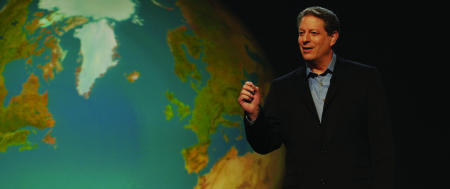The truth can be a bitter pill to swallow and An Inconvenient Truth contains the active ingredients: evidence of disruption of the Earth's atmosphere, biosphere, bathysphere, and cryosphere (ice cover). It shows how climate change presents the greatest challenge—and the grandest opportunity—facing the human race.
Hyperbole? Not according to Al Gore, who “used to be the next President of the United States,” as he breaks the emotional ice at the start of this fast paced film. With humour, humility, intelligence, and artistry, the film shows him traversing the globe. It paints a portrait of “Earth in the Balance” (the title of his 1992 book), perilously perched on a series of potential climatic tipping points.
Earth's polar ice caps have remained medium to large in size for more than 650 000 years, switching in tandem with levels of atmospheric carbon dioxide (CO2), ranging from 180 to 280 parts per million (ppm). At the current CO2 level of 380 ppm we are outside that envelope and are sailing swiftly into uncharted, ice starved seas. Systems seek equilibriums. But we will be fortunate if the climate is able to re-stabilise at a state that affords a modicum of predictability and offers us a second chance to radically change our energy diet.
The underappreciated truth is that the oceans have warmed 22 times more than the atmosphere. Increased evaporation from warmer sea surfaces fuels intense storms; but the upwelling of warm water from the depths generates sequences of severe storms. The changes in storm intensity and shifting in the circulation of the Atlantic Ocean observed today match the magnitude that models predicted would occur in 2080.
Using marvellous animations, the film portrays how sea water is warming, ice is melting, and water vapour is rising. It shows how the accelerating hydrological cycle is driving more droughts and more intense downpours. As temperatures and pressure gradients increase, it explains how this causes greater wind speeds and wider swings in weather.
The dwindling ice cover receives special attention in An Inconvenient Truth, with the stark warning that many montane glaciers will soon disappear. In Greenland, some outlet glaciers are heading towards the sea at a rate of 14km/year—twice the rate they were slipping only five years ago—caused by melt water seeping down through crevasses to lubricate their bases. Linear projections for the rise in sea level this century no longer apply, and this film, skilfully crafted by the director, David Guggenheim, graphically demonstrates the potential implications for coastal zones from London to Manhattan, and Calcutta to Shanghai.
The changes depicted hold enormous implications for human health and wellbeing. Global warming, greater variability in weather patterns, and changes to the timing of seasons are destabilising ecological dynamics. They are disrupting the annual rhythms of pollinators, affecting plant patterns, and predators, which are central in preventing prey from becoming pests and carriers of pathogens. The health of humans, forests, crops, wildlife, and marine life are all at stake. Coral reefs, the oldest habitat on Earth and the “medicine chests of the sea,” are under siege from warming induced bleaching and disease.
Figure 1.
Al Gore challenges viewers to respond to climate change
Credit: UIP/IMAGE.NET
Behind probing the orbital harmonics of global climate change and the disharmonies generated by burning fossil fuels and felling forests, An Inconvenient Truth contains an underlying, chaconne-like pulse of profound personal experiences: Gore's son's near death accident, which transformed his perspective on mankind's common future, and his sister's early death from lung cancer due to smoking, which led Gore's stricken father to abandon tobacco farming. The analogy between the tobacco industry's intransigence and untruths, and those still emanating from a flagging few fossil fuel companies are not lost on Gore.
We see a young Gore at Harvard in 1968, studying with Roger Ravelle, the eminent explorer of Earth's biogeochemical cycles, seeking to unravel the significance of the seesawing, up-ticking Keeling Curve—the critical measurement of atmospheric CO begun on the remote mountain peak of Mauna Loa, Hawaii, in 1957, the first International Geophysical Year. Gore's concern with global warming is no passing fancy.
The film stops short of solutions. But Gore is a cofounder of Generation Investment Management, a force in promoting the necessary shift of investments into clean technologies. Quantum jumps in losses from catastrophic weather events in the past two decades have stunned the financial sector; and institutional investors are readying to come about, given the right public policy signals.
The convenient truth is that, provided there is the proper magnitude of incentives and alignment of regulations, the clean energy transition can become the engine of growth for the 21st century. And the Al Gore we come to know through this adeptly arranged film may be just the statesperson who can to help the United States rejoin the community of nations in embarking on this essential project.
US release date: 24 May
UK release date: 8 September www.climatecrisis.net/
Rating: ★★★★
Items reviewed are rated on a 4 star scale (4=excellent)



